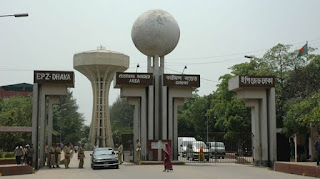Recently, Bangladesh
has made big progress in attracting Foreign Direct Investment (FDI). In 2018,
the maximum amount of FDI came in Bangladesh and it increased also among all
the LDC countries across the world. Bangladesh has the highest growth rate among
all the countries in South Asia. Last year, FDI rate increased by 68 percent
compared to the previous year whereas the FDI rate was 13 percent decreased in
the whole world. Hope more FDIs will come in this year as per previous contract
and announcement of several companies of the World.
The latest
international investment report of the United Nations Trade and Development
Organization, UNCTAD, shows the picture of foreign investment in Bangladesh.
According to the report published on 12 June 2019, in 2018 there was $ 3600
million net FDI in Bangladesh.
Japan
Tobacco has invested 1500 million dollars last year through the purchase of
local tobacco company Dhaka Tobacco which has had a positive impact on the
overall investment and the economic zones of public-private partnership
overall. UNCTAD this year report is based on the Special Economic Zones in
Bangladesh. UNCTAD evaluates more deeply the recent investments in the economic
zones of the country.
The
Government of Bangladesh has already taken some initiatives that are attracting
investment. Infrastructure development, gas and electricity supply system has
been improved. The problem of land has been resolved by establishing new economic
zones across the country. Besides, laws have been relaxed to facilitate the
transactions of foreign investors. Various initiatives including one stop
service have been taken to facilitate easy business process.
Executive
Chairman of Bangladesh Investment Development Authority (BIDA) Kazi M Aminul
Islam said, "Currently all the relevant related to investment in the
country is now present." Infrastructure development has progressed a lot.
One stop service for the investor has been started. Foreign entrepreneurs are
finding the young manpower of Bangladesh as positive. Their confidence is
increasing due to socioeconomic achievement. As a result, FDI is increasing.
But there is still some problem due to bureaucratic complexity and old laws
which needs reform. If there is a continuation of the current progress and some
necessary reforms done then FDI will increase further.
According
to the UNCTAD report, foreign direct investment in South Asia in 2018 was $
5,400 Crore, which is 4 percent more than the previous year. Vast majority of
this huge investment amount received by India. Last year foreign investment of
India increased 6 percent to amount 4,200 crores. Although Bangladesh's total
investment is low but growth rate is top in South Asia.
According
to UNCTAD, last year the total FDI amount in LDCs stood at $ 2,380 Crore, which
is 15 percent more than the previous year. Among the LDCs, the highest FDI came
in Bangladesh. Myanmar got FDI equivalent to 360 million dollars in Bangladesh
but it s 18 percent less than Myanmar's previous year's investment. Apart from
attracting FDI, the top five countries in the LDCs are Ethiopia, Mozambique and
Cambodia. Bangladesh is also at the top as a single company's investment.
Bangladesh
is also the leading country to attract new or Greenfield investment. The report
said that the United States General Electric, Japan's Mitsubishi and Summit
jointly announced to invest $ 300 crore to build oil and gas terminals in
Bangladesh. In addition, General Electric announced $ 300 crore investments in
fossil fuel electric power in Bangladesh. China's Huadian Corporation has shown
interest in investing around $ 1 billion in the same sector. In addition, General
Electric last year made another $ 440 crore investment in power generation.
UNCTAD said
in 2018 the FDI fell 13 percent to 1.3 trillion dollars around the Globe. After
the global economic downturn this was the lowest in the last decade. But
hopefully this year, FDI will increase further in some Asian and African
countries. The organization thinks that special economic zones and natural
resources on these continents are attracting foreign investors. FDI is coming
for the developing economic zones of public-private partnership in Bangladesh.
BIDA hopes that Bangladesh will receive $ 370 Crore FDI in the end of this
year.
The
government has constituted Bangladesh Economic Zone Authority or BEZA to speed
up economic growth. Granting of setting up of 30 economic zones has been
approved out of 24 is under construction. 4 economic zones are being built on
the basis of international partnership. Besides, more than 60 economic zones
are in the process of approval. Government planned to establish 100 economic
zones across the country. There are also existing eight governments and one private
Export Processing Zone - EPZ in the country. 72 percent of foreign investment
has been invested in these EPZs. And 20 percent of the country's total export
products are being manufactured from these factories.
Please visit the official website of UNCTAD for details about the report.
Related:
Industrial Sectors in Khulna is Increasing





No comments:
Post a Comment